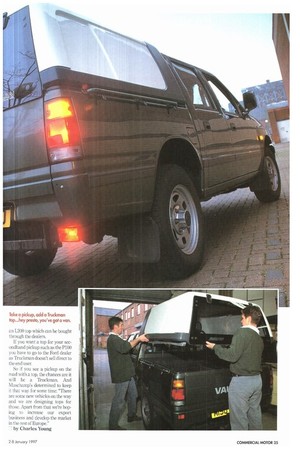TRUCKMAN
Page 36

Page 37

If you've noticed an error in this article please click here to report it so we can fix it.
Convertible vans? A top that goes up and down in a matter of minutes? It all sounds a bit glamorous for these pages, surely But before we start donning sunglasses and dusting down the surfboards, the conversion in question is that of turning a pickup into a van. Nor quite Hollywood but it does mean that by adding a glass fibre roof to a pickup's load area you get the pickup's high payload combined with a van's security
Truckman is the main manufacturer of these tops in the UK. Tucked away in a quiet corner of a Gloucester industrial estate, there are few outward signs of the company's success but with 70°0 of the tops business going its way and an annual turnover of „C1.2in the other players in the market are fairly small beer.
Truckman tops used to be made by Coachwork Walker, a bodybuilding company based in Lancashire.
But after the firm went into receivership in 1990, managing director John Muschamp bought out Truckman and moved the company down to Gloucester. He now runs it with his son Mark, There are Truckman tops for all pickups currently in production as well as for a few secondhand models such as Ford's P100 and Peugeot's 504. And with the company recording a growth of around 25'0 this year they are certainly in demand. John Muschamp puts this down to worries about security.
"A lot of people who have had pickups for a while are now finding they need extra protection from criminals and indeed the weather," he explains. "Our tops give these benefits but as they also come off in a matter of minutes you have the option of converting back to a pickup for ease of access."
• TAMPER-PROOF
Once the 100°0 fibre glass top has been fitted it can be removed by unscrewing six thumbscrews that attach it to the pickup's original sides. Despite this being a relatively simple procedure Muschamp is confident the top is tamper proof as the screws are not accessible from the outside.
"I've never heard of anyone taking a crowbar to the top," he says, "Besides, the easiest way to break in is to smash the glass door at the back. But even then you can't open the door. We also do a steel grid as an option to cover the glass."
If you're convinced a Truckman is the answer to your security worries you may be wondering what else the top can do for your business. The first thing that comes to mind is a greater surface area for sign writing. The shell itself is gel coated, not painted, at the factory and can be ordered in any non-metallic colour. And you can also paint directly on to the sides.
When it comes to payload potential, the top weighs an average of 50kg (weights vary slightly for different models).
The model line-up is straight forward. You can either go for the Classic range which fits to single cab pickups or the Aero Top range which was introduced after double cabs came to this country a couple of years ago. Both ranges have the option of either double-skinned roof and sides with a foam core —the S model— or a single-skinned roof with a stiffening spine and sides reinforced with Coremat hoops—the C model.
There are also a number of accessories available such as racking and shelving systems, side windows, rear wash/wipe and roof vent.
Truckman has a contract with Toyota, Nissan, Mazda, Tata, Volkswagen and Skoda under which the top is sold as an accessory to the vehicle. Vauxhall promotes the top but Truckman markets it direct to the dealers. The only manufacturer that Truckman has not yet cracked is Mitsubishi although it does make
an L200 top which can be bought through the dealers.
If you want a top for your secondhand pickup such as the P100 you have to go to the Ford dealer as Truckman doesn't sell direct to the end user.
So if you see a pickup on the road with a top, the chances are it will be a Truckman. And Muschamp's determined to keep it that way for some time: "There are some new vehicles on the way and we are designing tops for those. Apart from that were hoping to increase our export business and develop the market in the rest of Europe."
by Charles Young
















































































